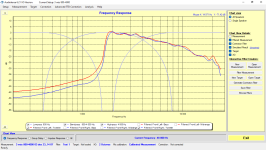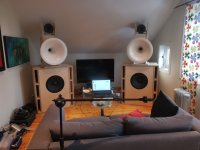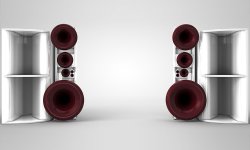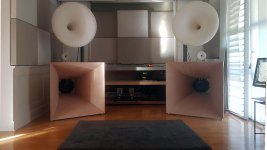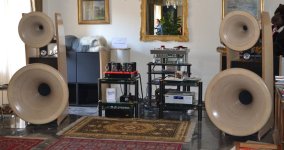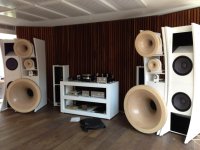I want to upgrade my 3 way active speaker with a better tweeter. Have celestion ftr15 3070c in Onken 360l, fostex 299 compression drivers such as mid, and BMS4538 as tweeters. I'm missing a bit at the top like crunch and details. The BMS is comfortable, but a little too kind.
BMS4538 mediates i JMLC 1000. Active sharing is currently set to 800Hz og 4000Hz.
BMS4538 mediates i JMLC 1000. Active sharing is currently set to 800Hz og 4000Hz.
Attachments
I have adjusted the tweeters in Audiolense, but I'm not such a fan of and eq too much. The most important thing is that the basis for the drivers is in the area you want, and than you can find suitable xo.
Better tweeter in what way? "Better" is not a technical term. You have a sloping down tweeter response as we see in the first pic? Do you listening to that way in the completed speaker? Or do you have a flat on-axis response but the sound is still dull? IMO a little confusing what you are after according to your description.
By the way, my personal experience is that Beryllium is currently the only material for compression driver diaphragms that can sounds satisfying up to the top of the high frequency range. Others opinion may vary.
By the way, my personal experience is that Beryllium is currently the only material for compression driver diaphragms that can sounds satisfying up to the top of the high frequency range. Others opinion may vary.
Last edited:
As YSDR says if that's your final response, with a filter, then you haven't used the tweeters correctly in the first place.
At a glance I had assumed that that response was the raw tweeter, very well behaved I thought, and a typical downward sloping response for the CD and horn. Obviously this needs the correct crossover to work well. EQ or crossover, the language doesn't matter, a crossover is just another implementation of equalisation, and you need to apply a filter that tilts the response back up.
I am assuming here that the response shown is an on-axis response rather than an, average, in-room power response type curve. Either way you've got two things working against things here. The first is that the horn will tilt the in-room power response down and the second is that the natural frequency response of a horn + CD will be tilted down too.
With horn/waveguide tweeters you normally apply a crossover that gives you a flat response on the axis that you've chosen for your design. Usually this is a little off-axis for horn/waveguides as the direct on-axis can be a bit wonky. Once you've got your flat frequency response, from your crossover, in place you then tilt the response up/down to suit your preferences.
Usually people prefer a downward tilt, say from 20Hz-20kHz, of about 5dB from low to high. You appear to have 20-25dB of downward tilt from 2kHz to 20kHz. The amount of tilt in the tweeter response will vary depending on your room acoustics and the directivity of the horn/waveguide used.
At a glance I had assumed that that response was the raw tweeter, very well behaved I thought, and a typical downward sloping response for the CD and horn. Obviously this needs the correct crossover to work well. EQ or crossover, the language doesn't matter, a crossover is just another implementation of equalisation, and you need to apply a filter that tilts the response back up.
I am assuming here that the response shown is an on-axis response rather than an, average, in-room power response type curve. Either way you've got two things working against things here. The first is that the horn will tilt the in-room power response down and the second is that the natural frequency response of a horn + CD will be tilted down too.
With horn/waveguide tweeters you normally apply a crossover that gives you a flat response on the axis that you've chosen for your design. Usually this is a little off-axis for horn/waveguides as the direct on-axis can be a bit wonky. Once you've got your flat frequency response, from your crossover, in place you then tilt the response up/down to suit your preferences.
Usually people prefer a downward tilt, say from 20Hz-20kHz, of about 5dB from low to high. You appear to have 20-25dB of downward tilt from 2kHz to 20kHz. The amount of tilt in the tweeter response will vary depending on your room acoustics and the directivity of the horn/waveguide used.
If the frequency-response chart in the OP is measured at the listening position, then the falling high-frequency must surely be a large contributor. This is fairly typical of many types of horn/waveguide, and may not be affected very much at all by changing the compression driver.
The frequency response is related to the directivity of the horn or waveguide. So trying to change the response with hardware (new horn/waveguide) will have significant affect on dispersion or directivity. Only you can say if your requirements can be met by different horn profiles..
Personally I consider directivity to be quite important and frequency-response to be very important. So I wouldn't want to compromise very much on either, and definately not just to avoid relatively tiny disadvantages of (electronic or software) response correction/equalisation. In a home system, anyway, where quality rather than maximum SPL is usually the objective.
The frequency response is related to the directivity of the horn or waveguide. So trying to change the response with hardware (new horn/waveguide) will have significant affect on dispersion or directivity. Only you can say if your requirements can be met by different horn profiles..
Personally I consider directivity to be quite important and frequency-response to be very important. So I wouldn't want to compromise very much on either, and definately not just to avoid relatively tiny disadvantages of (electronic or software) response correction/equalisation. In a home system, anyway, where quality rather than maximum SPL is usually the objective.
If you study the plot, you will see that I have removed the mid and low from the graph. Thought it was easier to be able to show tweeters for yourself.
Attaches complete plot including correction.
My point about the response of the tweeters is too little response from 10k Hz and up. This also comes out in the plot.

Attaches complete plot including correction.
My point about the response of the tweeters is too little response from 10k Hz and up. This also comes out in the plot.
Do you have any experience with the BlieSMa T25B-6?my personal experience is that Beryllium is currently the only material for compression driver diaphragms that can sounds satisfying up to the top of the high frequency range
If the grey line is the actual measured response then the only thing you need to do is tilt the 10-20k region up. I have no idea why you haven't done this as you've applied massive response shaping already to the tweeter.
In my experience playing with tilt, either up or down, in the 5-10k region is the last thing you need to do when voicing a speaker. Basically adjusting how much 'air' or 'sparkle' the system has. Too much and your ears melt off and it's obvious when this happens. Too little and the speaker still sounds good but you always feel that there's something lacking.
In my experience playing with tilt, either up or down, in the 5-10k region is the last thing you need to do when voicing a speaker. Basically adjusting how much 'air' or 'sparkle' the system has. Too much and your ears melt off and it's obvious when this happens. Too little and the speaker still sounds good but you always feel that there's something lacking.
I have tried to increase the response several dB without better results.If the grey line is the actual measured response then the only thing you need to do is tilt the 10-20k region up. I have no idea why you haven't done this as you've applied massive response shaping already to the tweeter.
I'm going to do some more troubleshooting to see if there's anything weird somewhere. Others have noted that BMS 4538 should be airy upwards. Maybe I will get these drivers new to rule out that there is something wrong with them 🤔
Perhaps but the horn/waveguide is going to play a large part in this with the way it integrates with your room acoustics.
If you want to give another compression driver a go you could always try some of the cheap ones from SB Acoustics or Tymphany. Especially if you can pick ones with different characteristics as an experiment.
If you want to give another compression driver a go you could always try some of the cheap ones from SB Acoustics or Tymphany. Especially if you can pick ones with different characteristics as an experiment.
Last edited:
Yes, I heard those at a friend of mine in his 3 way speakers, but they are not compression drivers. They sounded fine to me BTW.Do you have any experience with the BlieSMa T25B-6?
My experience with Audiolense as well as Acourate and DEQX is that it takes lots and lots of trial and error to get it sounding right. 90% of the time it does something right but at the same time it just robs some life and "sparkle" out of the loudspeakers. It is highly dependant on the measurement results so learning how to measure coreectly is step one. Just pointing a mic from the listening position and letting the software do the rest has never let to a satisfactionary result. Step two is learning to know what you prefered "housecurve" is. This is highly dependant on listening habits (how loud for instance) ,taste, room acoustics and dispersion characterisitics of your loudspeakers. Just copying popular houscurves online have never let to staisfactionary results. In other words, you have a very powerfull tool but I guess the most beneficial "upgrade" is to deeply learn how to use it.
But start with taking the tweeters physically down, at this moment you are mostly listening off-axis from them.
But start with taking the tweeters physically down, at this moment you are mostly listening off-axis from them.
I downloaded the BMS4538 datasheet from bms. The 1" CD has a nasty downturn of 5 minor divisions from peak at 2500 hz to 10000 hz, and another 2 1/2 minor divisions to 15 khz. They do not label how big a division is. I think the BMS claim of 30000 hz response is a sale gimmick, it is 5 minor divisions down there from 2500. I can only hear to 14 khz.
OTOH a B&C DE100 has the same output at 15 khz as at 2 khz with + 3 db peaks 1500 hz, 4000 hz, and 17 khz.
I think you can do better than the BMS4538. The eminence N314-T8 I just bought show only 3 db variation from 1000 to 15000 hz an only 5 db down from 1000 at 17000 hz. Unfortunately at 1.4" they will not fit your horn. The 1" Eminence PSD2002-8 is not nearly as flat as the B&C DE100 or the N314T-8.
Per SJF, I point my horns at my listening position, not straight out. Peavey points the flat axis 15 deg down from horizontal to cover large areas of rooms from poles 2m in the air. That is how my SP2(2004) are mounted. As I sit to the left of the room, the right speaker is turned more towards my seat than the left. The woofers cover to 1800 hz so those are 2 m above floor level, also. When I build the N314T-8 onto a 2 way, the back of the CD will be jacked up so the sound points down, to emulate Peavey's design. The trouble with peavey, one pair has been stolen already, and with the logo visible through my front window, and the pawnshop value of the SP2, I expect theft will happen again. The Eminence 2 way will be built really ugly.
OTOH a B&C DE100 has the same output at 15 khz as at 2 khz with + 3 db peaks 1500 hz, 4000 hz, and 17 khz.
I think you can do better than the BMS4538. The eminence N314-T8 I just bought show only 3 db variation from 1000 to 15000 hz an only 5 db down from 1000 at 17000 hz. Unfortunately at 1.4" they will not fit your horn. The 1" Eminence PSD2002-8 is not nearly as flat as the B&C DE100 or the N314T-8.
Per SJF, I point my horns at my listening position, not straight out. Peavey points the flat axis 15 deg down from horizontal to cover large areas of rooms from poles 2m in the air. That is how my SP2(2004) are mounted. As I sit to the left of the room, the right speaker is turned more towards my seat than the left. The woofers cover to 1800 hz so those are 2 m above floor level, also. When I build the N314T-8 onto a 2 way, the back of the CD will be jacked up so the sound points down, to emulate Peavey's design. The trouble with peavey, one pair has been stolen already, and with the logo visible through my front window, and the pawnshop value of the SP2, I expect theft will happen again. The Eminence 2 way will be built really ugly.
The bms 4538 has a perfectly normal freq response for a 1 inch compression driver and like any compression driver it needs eq unless you are going to use old fashioned exponential horns that amplify the highs but are also beaming like crazy on top. The downfall in the freq response is because of the mass of the diaphragm, the peak in the highs is caused by diaphragm break-up and because of the exit diameter becoming to big to load the driver. That’s how compression drivers work. The smaller b&c driver might be better in the highs because it has a smsller disphragm, hence lighter and thus freq downslope starting higher and higher breakup frequency. But it probably won’t go as low as the bms. Pick the best one for the freq range within it has to operate. Compression drivers only work at best in a two octaves range, above and below that it’s always a compromise.
- Home
- Loudspeakers
- Multi-Way
- Better tweeters
